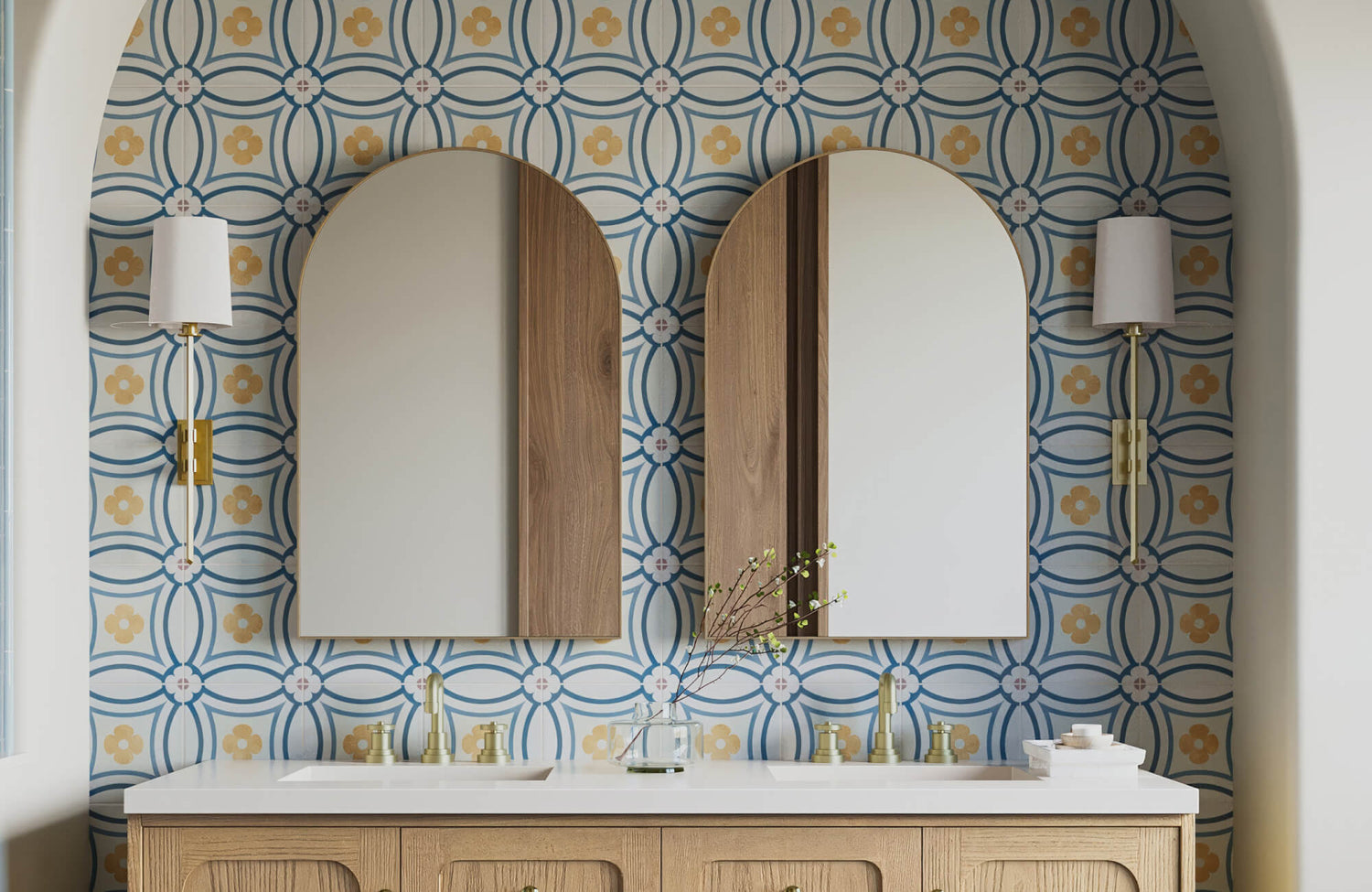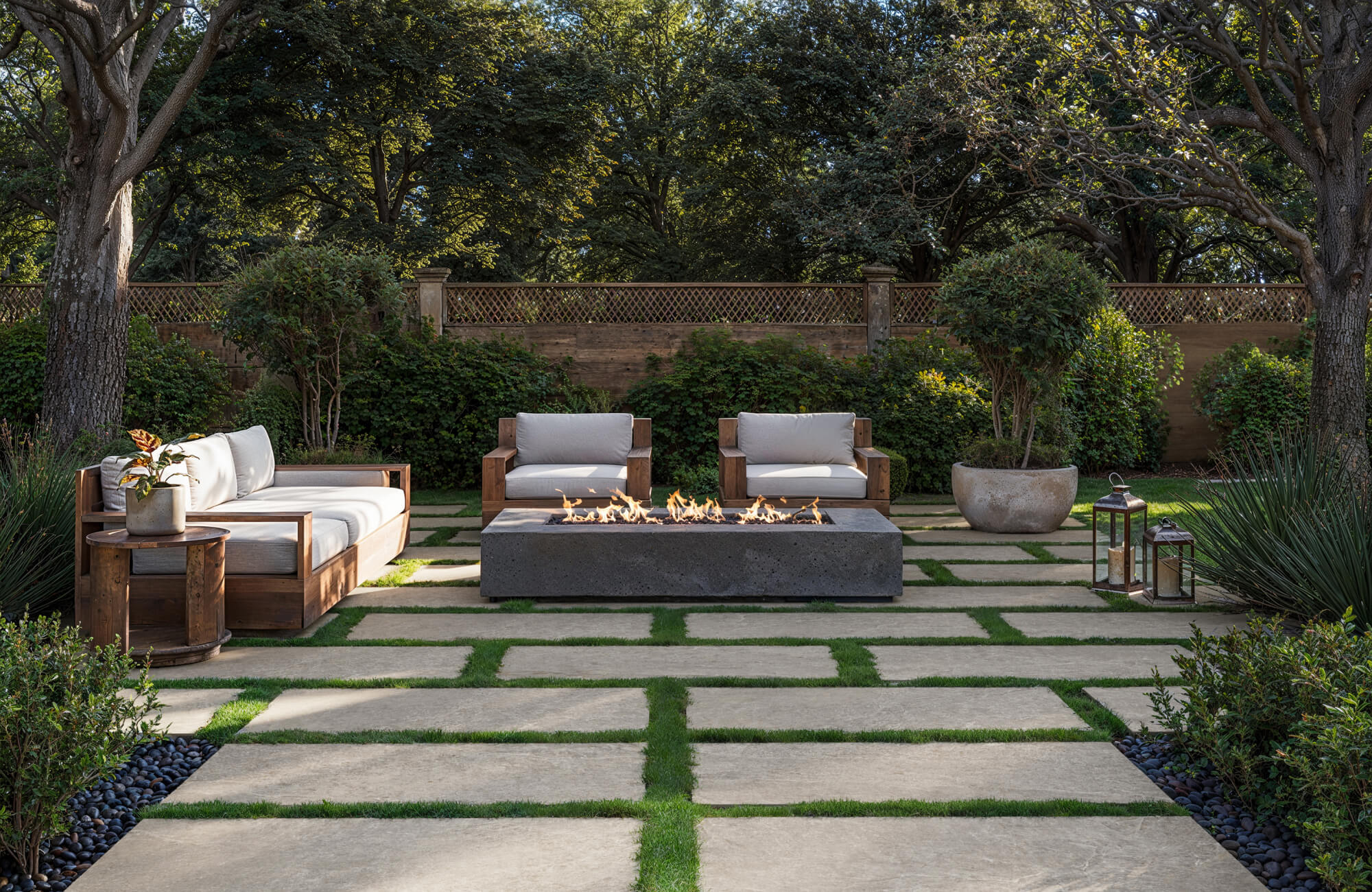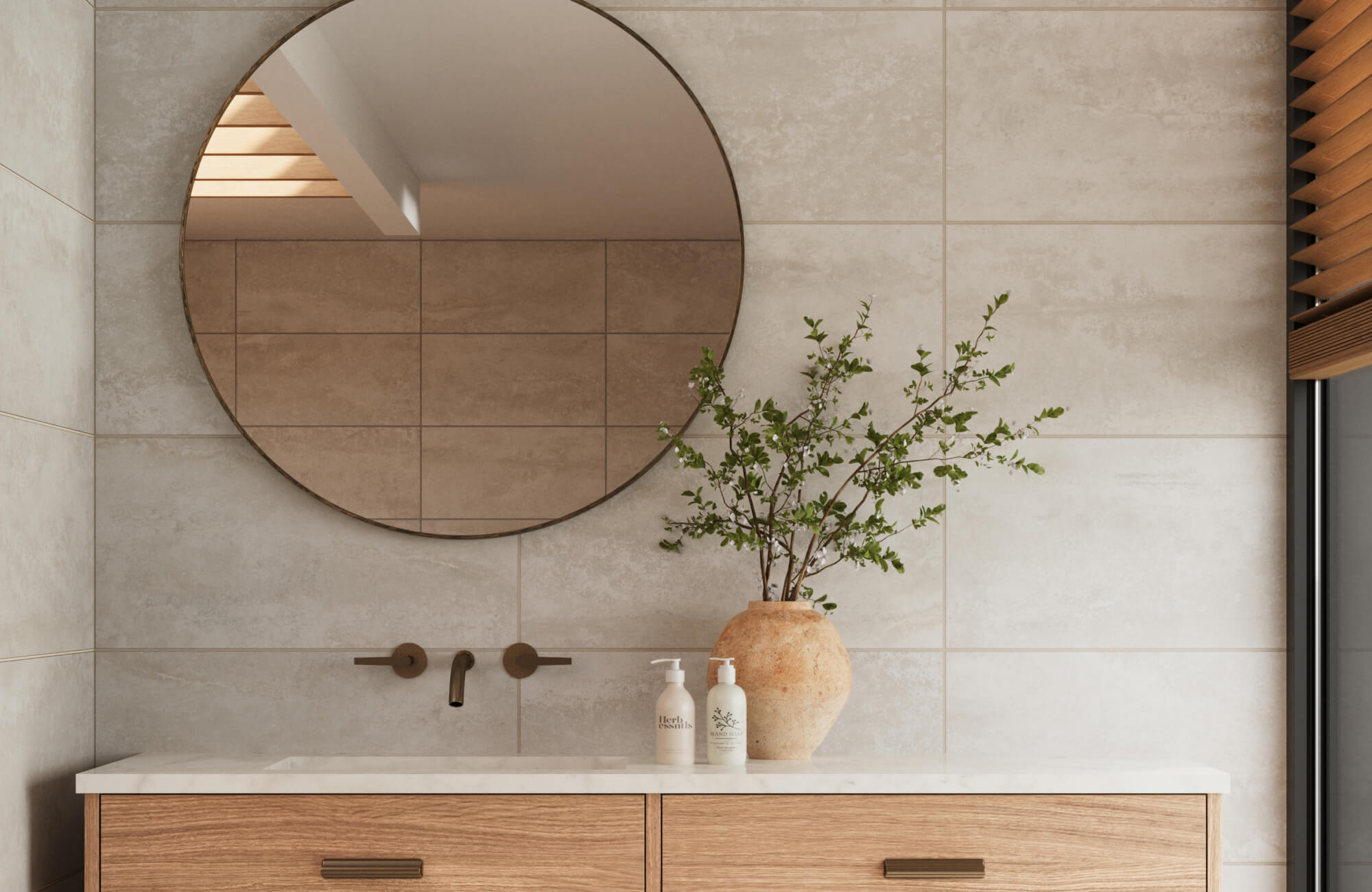Porcelain and ceramic tiles are two of the most popular materials for backsplashes, and for good reason. They’re both durable, versatile, and come in a wide range of finishes that suit nearly any style. But while they may look similar on the surface, they differ in a few key ways that can affect long-term performance, ease of installation, and care.
In this article, we’ll explore what sets these two materials apart, from how they’re made to how they hold up over time, so you can choose the one that best fits your backsplash needs, whether in a kitchen, bathroom, or anywhere else.

Porcelain vs. Ceramic: What's the Core Difference?
Porcelain and ceramic tiles may look similar at a glance, but their core makeup is where the real difference lies. Both are made from clay, but porcelain uses a finer, more refined clay blend that’s fired at much higher temperatures. This process results in a denser, harder tile with a more uniform structure throughout. Ceramic, on the other hand, is made from a slightly coarser clay and fired at lower temperatures, which leaves it a bit more porous and lighter in feel.
This difference in density directly affects how each tile handles water. Porcelain has a lower water absorption rate, typically less than 0.5%, making it virtually non-porous. Ceramic tiles, such as our Claire 3x12 Glossy Ceramic Tile in Eggshell above, are more absorbent in comparison, which is something to keep in mind for moisture-prone areas, even though both are often glazed for added protection. These absorption rates are determined through standardized testing, and they’re key indicators of long-term performance, especially in rooms exposed to humidity or splashes.
It’s also worth noting that because porcelain is denser, it tends to be heavier and slightly harder to cut. This isn’t necessarily a drawback, but it does influence how the material is handled during installation, which will be discussed in a later section. For now, what matters most is understanding how the firing process and clay composition create meaningful performance differences between the two. The right choice often starts with knowing what’s beneath the surface.
Porcelain and Ceramic Tile Ratings You Should Know
When choosing tile for a backsplash, it helps to understand the technical ratings that determine surface strength and suitability. One key factor is the PEI rating, which measures a tile’s resistance to surface wear. For backsplashes, a PEI rating of 1 or 2 is usually more than enough, since these areas don’t endure heavy usage or heavy impact. Also worth noting is that wall tiles don’t need to meet the same durability standards as floor tiles, so a high PEI number isn’t always necessary here.
Scratch resistance is another useful spec to consider, often measured using the MOHS scale. This rating tells you how well the tile can resist surface scratches from everyday kitchen use, like the occasional brush of a utensil or cookware. While backsplashes don’t take the same level of abuse as countertops or flooring, choosing a tile with a decent MOHS rating helps maintain its look over time. Make sure the tile is clearly labeled for wall use, too, as not all options, especially floor-rated ones, are appropriate for vertical applications.
Glazed vs. Unglazed Options for Backsplashes
One of the most noticeable differences between tile finishes is whether the surface is glazed or unglazed. Glazed tiles have a protective glass-like coating that can appear glossy or matte, depending on the style. This layer not only adds visual depth but also helps resist stains, splashes, and general kitchen mess. For backsplashes, glazed finishes are often preferred because they’re easy to wipe down and help prevent discoloration from things like grease or food splatter.
Unglazed tiles, on the other hand, have a more natural, raw surface with a softer, matte appearance. They offer a more organic or textured look, which can be appealing in certain design styles, but they tend to be slightly more porous. While some unglazed tiles perform well in dry areas, they usually require sealing to protect against moisture and staining, especially in active kitchen environments. If low maintenance is a priority, glazed tiles typically offer a more practical, easy-care solution for daily cooking zones.
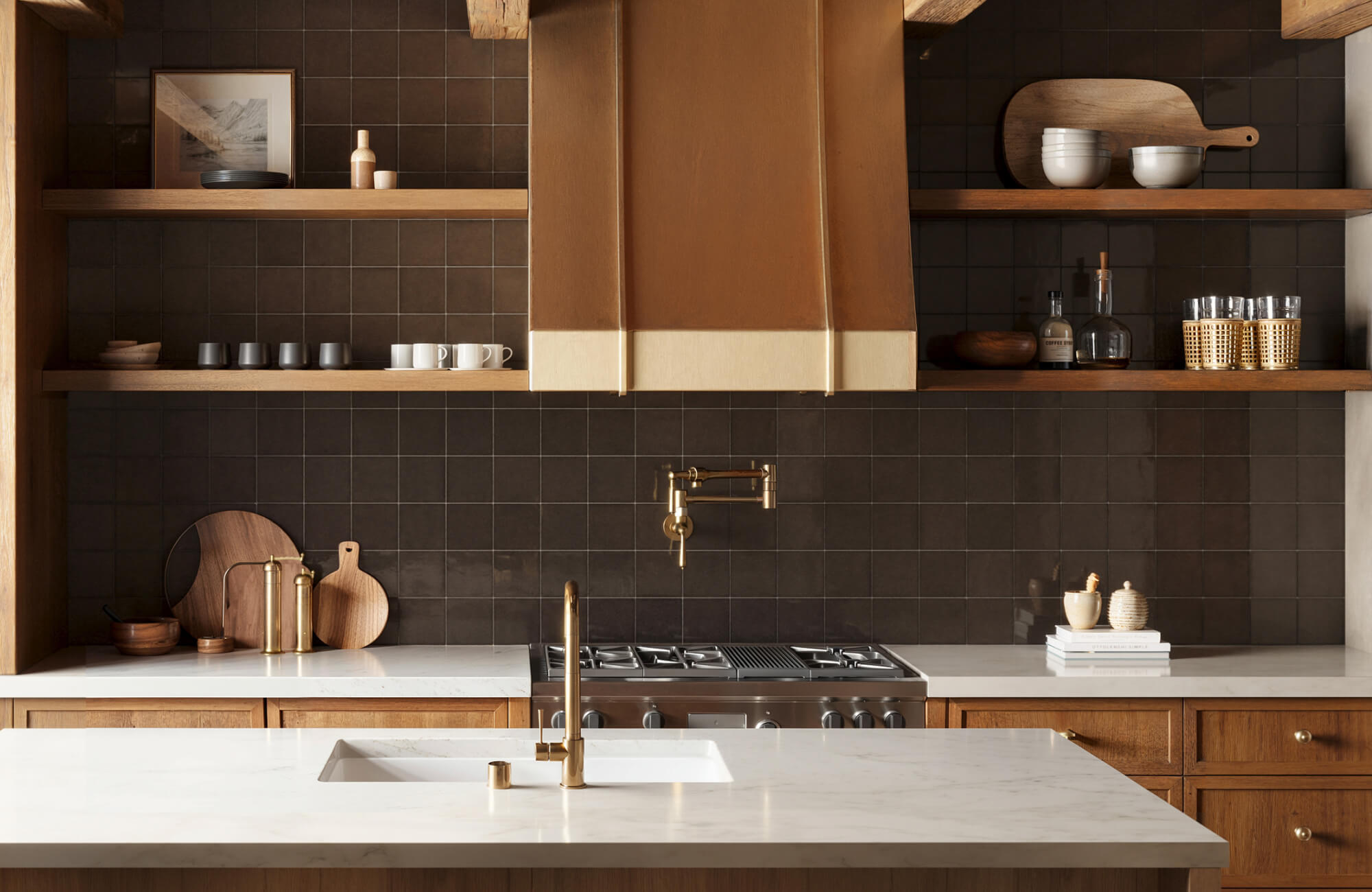
Aesthetic & Design Possibilities
Porcelain and ceramic tiles each offer a wide range of aesthetic options, but the way those options are applied can differ slightly between the two. Ceramic tiles, like our Mikayla 5x5 Glossy Ceramic Tile in Espresso above, are often known for their colorful glazes and painterly surface designs, which can bring warmth and personality to a backsplash. These tiles commonly feature hand-painted motifs, decorative borders, or subtle tonal shifts that work beautifully in classic or cottage-style kitchens.
Porcelain tiles, while just as versatile, tend to lean more into printed patterns and realistic textures. Because of their density, they’re better suited for digital printing techniques that mimic materials like stone, wood, or even concrete. This makes them ideal for modern or transitional spaces where a more refined, seamless look is desired. Also, the surface texture of porcelain can range from smooth and polished to lightly textured, offering visual interest without overwhelming the overall design.
Both materials can support bold colors or understated neutrals, depending on the effect you want to achieve. For example, porcelain might be chosen for its clean, uniform look in a minimalist kitchen, while ceramic can add charm through variation and handcrafted appeal. Each brings something different to the table, so the best choice often comes down to the style direction you're going for and how much visual movement you want in the backsplash.
Tile Size and Shape Differ Between Porcelain and Ceramic
Size and shape may seem like small details, but they can make a big difference in how a backsplash ties into the rest of your design. Porcelain and ceramic tiles offer a range of options, but certain styles tend to show up more frequently in one material. These subtle differences can influence how the space feels overall, whether it leans more traditional, minimal, or decorative.
Subway and Rectangular Formats
Subway tiles are common in both porcelain and ceramic, though ceramic tends to offer more variety in surface finishes and subtle tonal shifts. This format works well in staggered, stacked, or herringbone layouts, bringing clean lines and a timeless feel to the backsplash. Porcelain options are available too, especially in larger, more modern interpretations. If you’re aiming for a classic layout with added character, ceramic often brings more depth in this shape.
Mosaics and Small Formats
Porcelain is often the preferred choice for mosaic and small-format tiles, especially when it comes to detailed shapes like hexagons or tiny squares. These designs require strength and consistency, which porcelain handles well due to its density. The result is a tighter, more refined layout with crisp grout lines and minimal risk of cracking. Ceramic mosaics are available too, but they usually appear in more decorative or handcrafted designs rather than structured grids.
Large-Format Tiles
Large-format tiles are more commonly found in porcelain, as it can be produced in thinner, wider panels without compromising durability. These tiles help create a sleek, uninterrupted look with fewer grout lines, which works well in more minimalist or contemporary kitchens. Ceramic tiles are typically made in smaller sizes, making them better suited to classic or more intricate backsplash layouts. If you’re after visual simplicity and a smooth finish, porcelain tends to offer more flexibility at larger scales.

Durability and Resistance to Moisture
Porcelain and ceramic tiles are both solid options for kitchen backsplashes, but there are a few key differences in how they handle moisture and everyday wear. Porcelain’s density makes it naturally more resistant to water, which helps it hold up well in steamy areas or spots that get regular splashes. Its non-porous surface means spills and splatter are less likely to soak in or cause stains, especially behind stoves or sinks where moisture tends to build up, as seen above with our Natasha 2x6 Matte Porcelain Tile in Denim.
Ceramic tiles perform well, too, particularly when glazed, but they are slightly more absorbent than porcelain by nature. This doesn’t mean they’re a poor choice—just that they benefit more from proper sealing and regular care in high-moisture zones. A well-maintained ceramic backsplash still offers great durability, especially in areas where water exposure is occasional rather than constant. It’s also worth noting that most ceramic tiles used for backsplashes are designed with water resistance in mind.
Both materials can handle everyday kitchen messes without issue, but if long-term strength and minimal upkeep are priorities, porcelain may have a slight edge. Its lower water absorption rate helps prevent damage over time and makes cleaning even more straightforward. That said, ceramic remains a dependable, practical choice when selected and maintained appropriately, especially if the design or finish is the driving factor.
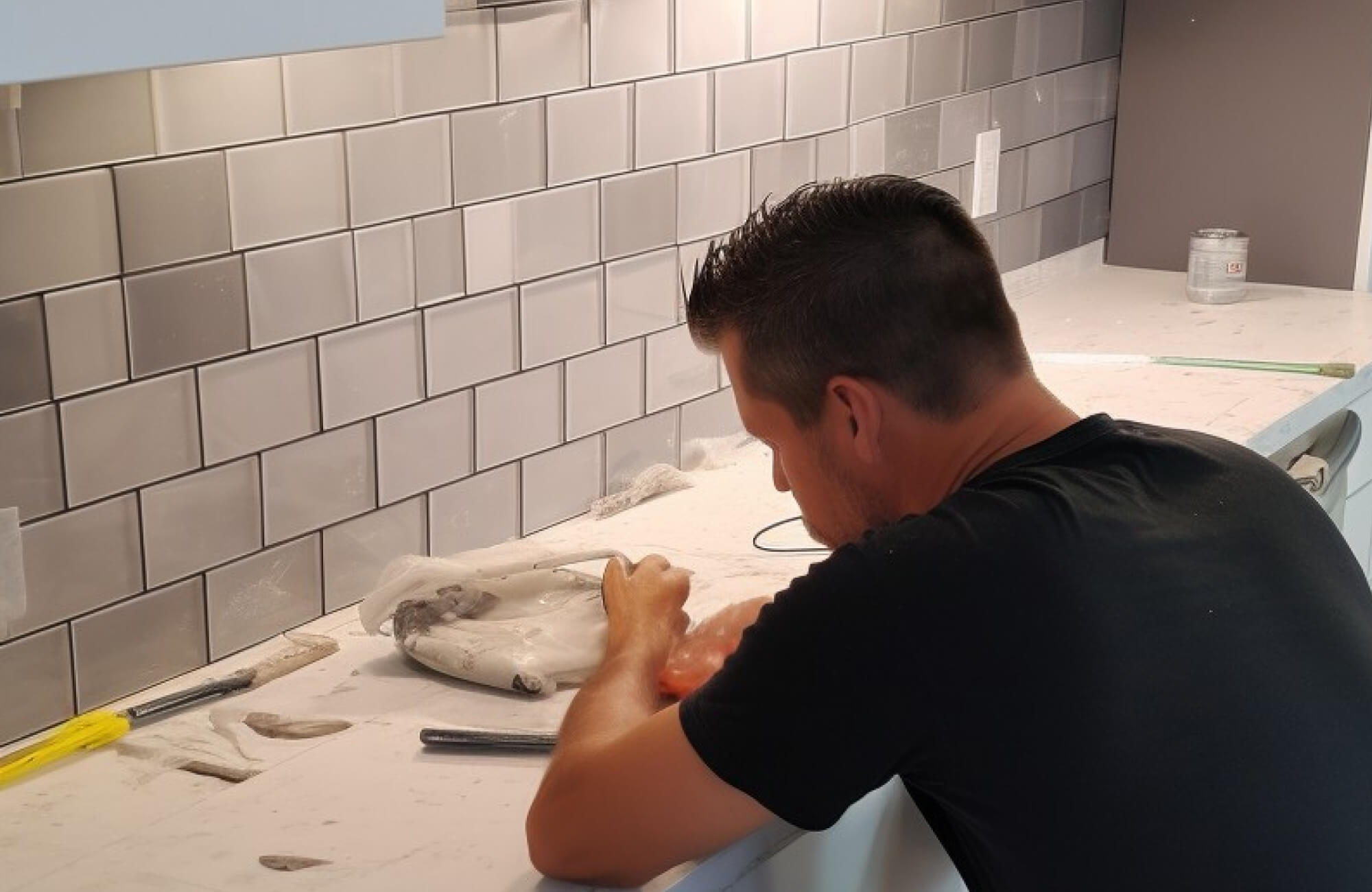
Ease of Installation
While porcelain and ceramic tiles can both be used for backsplashes, the experience of working with them isn’t always the same. Some materials are more DIY-friendly, while others may require extra tools or time to get clean, accurate cuts. Whether you're installing it yourself or hiring a pro, it's helpful to know how each material handles during the process.
Cutting and Handling
Ceramic tiles are generally easier to cut and shape, which makes them a popular choice for DIY installations. They’re lighter in weight and less dense, so basic tile tools, like a manual snap cutter, are often enough for clean edges. Porcelain, by contrast, is much denser and requires a wet saw with a diamond blade to prevent chipping. The added effort is manageable, but it does raise the level of skill and time involved.
Tool and Skill Requirements
Because porcelain is harder and heavier, it typically demands more specialized tools and a steady hand to work with. This can add complexity for beginners or increase labor costs if you're hiring someone to install it. Ceramic tiles, on the other hand, are more forgiving and easier to adjust mid-installation. For simple backsplash layouts, ceramic often gives you more flexibility with fewer tools.
Overall DIY Friendliness
For homeowners handling their own install, ceramic tends to be the more approachable option. It cuts easily, lays smoothly, and doesn’t put as much strain on standard tools. Porcelain can still be a great choice, but it’s often better suited for experienced DIYers or professional installs. If ease and speed are priorities, ceramic offers a more user-friendly path from start to finish.
Maintenance and Long-Term Upkeep
Both porcelain and ceramic tiles are low-maintenance by design, which adds to their appeal in kitchen environments. On a daily basis, wiping them down with a damp cloth and a gentle cleaner is usually all it takes to handle grease, splashes, or cooking residue. Since most backsplash tiles are glazed, they naturally resist staining and don’t absorb grime easily, making upkeep quick and manageable.
Long-term, porcelain tends to require even less attention due to its lower absorbency and dense surface. It typically doesn’t need sealing and holds up well to buildup over time. Ceramic performs reliably, too, but unglazed or matte finishes may benefit from occasional sealing to prevent staining. As with any material, avoiding harsh cleaners and maintaining a regular routine helps keep the surface looking clean and intact for years to come.

Cost Comparison and Value Over Time
When it comes to material costs, ceramic tiles are generally the more budget-friendly option. They’re less expensive to produce and easier to work with, which can also lower the overall installation cost. This makes ceramic a great choice for projects with tighter budgets or for covering larger areas without compromising on quality. Despite the lower price point, ceramic still offers reliable durability for backsplash use.
Porcelain tiles usually cost more up front, both in terms of material and labor. Their density makes them tougher to cut and install, which can increase the time and effort required. However, that extra investment often comes with a longer lifespan and fewer maintenance needs down the road. For homeowners who want a high-performance, long-lasting material, porcelain may offer better value over time.
Both options bring solid returns when used in the right setting, but the best choice depends on your priorities. If upfront savings and flexibility are important, ceramic delivers strong performance at a lower cost. If you’re looking for something that lasts with minimal upkeep, porcelain might be worth the higher initial investment. Either way, both materials are built to stand the test of time in backsplash applications.
Making the Smart Choice for Your Backsplash
Choosing between porcelain and ceramic for your backsplash ultimately comes down to how you balance performance, style, and budget. Porcelain offers denser strength, lower absorption, and long-term durability, while ceramic brings flexibility, approachable pricing, and a wider range of handcrafted looks. Both can serve your space well, it just depends on what matters most in your day-to-day routine.
If you're still unsure which material best suits your kitchen, we're here to help. Our personalized design consultation offers guidance tailored to your layout and style preferences. You can also order free tile samples to see the finish, color, and texture in your own space before making a final choice.





